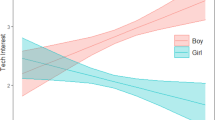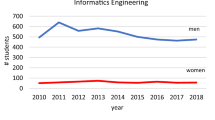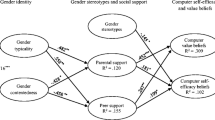Abstract
This study examined Spanish young people’s gender-stereotyped beliefs and attitudes about people working in the field of information and communications technology (ICT). For this purpose, their positive, negative, and neutral perceptions of the associated characteristics of these workers were also analyzed. Likewise, the use of masculine, feminine, or neutral expressions to describe these professionals was explored. The existence of gender differences in these aspects was also investigated. 900 students from Catalonia (51 % girls) enrolled in the last course of junior secondary education (mean of age=15 years old; S.D. = 1.73) participated in a survey with close and open-ended questions. Content analysis of responses to an open-ended question indicated that the boys and girls held several stereotypical beliefs about ICT professionals (a highly male-dominated field), but they also reported counter-stereotypical beliefs about them. As expected, these stereotypical beliefs described a masculine portrayal of ICT workers. Contrary to expectations, most of the students’ portrayals of people working in ICT were either positive or neutral, not negative. Likewise and opposite to predictions, young males did not show more positive attitudes towards ICT professionals than girls. In fact, both girls and boys evaluated more positively than negatively the different descriptive aspects associated with ICT professionals. In support of expectations, most boys and girls referred to masculine role models working in ICT. No gender differences were observed in the type of characteristics associated with ICT professionals. However, young females were more likely to offer feminine references about professions where ICT is the tool rather than the object of their work. The theoretical and practical implications of these findings within the context of Spain are discussed.
Similar content being viewed by others
References
Abbiss, J. (2008). Rethinking the “problem” of gender and IT schooling: Discourses in literature. Gender and Education, 20, 153–165. doi:10.1080/09540250701805839.
Bair, B., & Marcus, M. (2007). Women’s interest in information technology: The fun factor. In C. J. Burger, E. G., Creamer, & P. S. Meszaros (Eds.), Reconfiguring the firewall: Recruiting women to information technology across cultures and continents (pp. 161–175).Wellesley, MA: A K Peters, Ltd.
Barker, L. J., & Aspray, W. (2006). The state of research on girls and IT. In J. M. Cohoon & W. Aspray (Eds.), Women and information technology: Research on underrepresentation (pp. 3–54). Cambridge, MA: The MIT Press.
Bandura, A. (1999). Self-efficacy in changing societies. London: Cambridge University Press.
Boroditsky, L., Schmidt, L. & Phillips, W. (2003). Sex, syntax, and semantics. In D. Gentner & S. Goldin-Meadow (Eds.), Language in mind: Advances in the study of language and cognition (pp. 61–79). Boston, MA: Massachusetts Institute of Technology
Bussey, K., & Bandura, A. (1999). Social cognitive theory of gender development and differentiation. Psychological Review, 106, 676–713. doi:10.1037/0033295X.4.676.
Castaño, C. (Ed.). (2011). Género y TIC. Presencia, posición y políticas. [Gender and ICT. Presence, position, and politics]. Barcelona: Editorial UOC.
Cejka, M. A., & Eagly, A. H. (1999). Gender-stereotypic images of occupations correspond to the sex segregation of employment. Personality and Social Psychology Bulletin, 25, 413–423. doi:10.1177/0146167299025004002.
Cheryan, S., Drury, J., & Vichayapai, M. (2012). Enduring influence of stereotypical computer science role models on women’s academic aspirations. Psychology of Women Quarterly, 37, 72–79. doi:10.1177/0361684312459328
Cheryan, S., Play, V. C., Handron, C., & Hudson, L. (2013). The stereotypical computer scientist: gendered media representations as a barrier to inclusion for women. Sex Roles, 69, 58–71. doi:10.1007/s11199-013-0296-x.
Deaux, K., & Lewis, L. L. (1984). Structure of gender stereotypes: Interrelations among components and gender level. Journal of Personality and Social Psychology, 46, 991–1004. doi:10.1037/0022-3514.46.5.991.
Diario Médico [Medical News] (2014). Colegiación médica. Las mujeres escasean en lascúpulas. [Medical collegiates. Women are scarce on the top]. Retrieved from http://www.diariomedico.com/2014/04/28/area-profesional/sanidad/mujeres-escasean-cupulas
Eagly, A. H. (2001). Social role theory of sex differences and similarities. In J. Worell (Ed.), Encyclopedia of women and gender (pp. 1069–1079). San Diego,CA: Academic.
Eagly, A. H., Wood, W., & Diekman, A. (2000). Social role theory of sex differences and similarities: A current appraisal. In T. Eckes & H. M. Trautner (Eds.), The developmental social psychology of gender (pp. 123–174). Mahsawah, NJ: Erlbaum.
Eccles, J. S. (1994). Understanding women’s educational and occupational choices. Applying the Eccles et al. model of achievement-related choices. Psychology of Women Quarterly, 18, 585–609. doi:10.1111/j.1471-6402.1994.tb01049.x
Eccles, J. S. (2007). Where are all the women? Gender differences in participation in physical science and engineering. In J. S. Ceci & W. M. Williams (Eds.), Why aren’t more women in science? Top researchers debate evidence (pp. 119–210). Washington: American Psychological Association.
Eccles, J. S., Barber, B., & Jozefowicz, D. (1999). Linking gender to educational, occupational and recreational choices: Applying the Eccles et al. model of achievement-related choices. In W. B. Swann, J. H. Langlois, & L. A. Gilbert (Eds.), Sexism and stereotypes in modern society (pp. 153–191). Washington: American Psychological Association.
Goode, J., Estrella, R., & Margolis, J. (2006). Lost in translation: Gender and high school computer science. In J. M. Cohoon & W. Aspray (Eds.), Women and information technology: Research on underrepresentation (pp. 89–114). Cambridge, MA: The MIT Press.
Greenwald, A. G., & Banaji, M. R. (1995). Implicit social cognition: Attitudes, self-esteem, and stereotypes. Psychological Review, 102, 4–27. doi:10.1037//0033-295x.102.1.4.
Gygax, P., & Gabriel, U. (2011). Gender representation in language: More than meets the eye. In R. Mishra & N. Srinivasan (Eds.). Language and cognition: State of the art (pp.72-92). Münich: Lincom AP
Hayes, A. F., & Krippendorff, K. (2007). Answering the call for a standard reliability measure for coding data. Communication Methods and Measures, 1, 77–89. doi:10.1080/19312450709336664.
Hellinger, M. & Bußmann, H. (2003). The linguistic representation of women and men. In M. Hellinger& H. Bußmann, (Eds.) Gender across languages: The linguistic representation of women and men. (Vol. 2, pp. 1–26). Amsterdam: John Benjamin’s Publishing Company
Holland, J. L. (1985). Making vocational choices. A theory of personalities and workenvironments. Englewood Cliffs, NJ: Prentice Hall.
INE [Spanish Statistical Office] (2014). Indicadores Sector TIC [Indicators ICT Sector]. Retrieved from http://www.ine.es/jaxi/menu.do?type=pcaxis&path=%2Ft14%2Fp197%2Fe01&file=inebase&L=0
Instituto de la Mujer [Women’s Institute] (2012). Statistics. Retrieved from http://www.inmujer.gob.es/ss/Satellite?c=Page&cid=1264005678200&language=cas_ES&pagename=InstitutoMujer%2FPage%2FIMUJ_Estadísticas.
Konishi, T. (1993). The semantics of grammatical gender. A cross-cultural study. Journal of Psycholinguistic Research, 22, 519–534. doi:10.1007/BF01068252.
Levy, G. D., Sadovsky, A., & Troseth, G. L. (2000). Aspects of young children’s perceptions of gender-typed occupations. Sex Roles, 42, 993–1005. doi:10.1023/A:100784516910.
Liben, L. S., Bigler, R. S., & Krogh, H. R. (2002). Language at work: Children’s gendered interpretations of occupational titles. Child Development, 73, 810–828. doi:10.1111/1467-8624.00440.
Lockwood, P. (2006). “Someone like me can be successful”: Do college students need same gender role models? Psychology of Women Quarterly, 30, 36–46. doi:10.1111/j.1471- 6402.2006.00260.x.
López-Sáez, M., Puertas, S., & Sáinz, M. (2011). Why don’t girls choose technological studies? Adolescents’ stereotypes and attitudes towards studies related to medicine or engineering. Spanish Journal of Psychology, 14, 71–84. doi:10.5209/rev_SJOP2011.v14.n1.6.
Margolis, J., & Fisher, A. (2002). Unlocking the clubhouse: Women in computing. Cambridge, MA: MIT Press.
Meszaros, P. S., Lee, S., & Laughlin, A. (2007). Information processing and IT career interest/choice among high school students. In C.J. Burger, E.G. Creamer & Meszaros (Eds.), Reconfiguring the firewall. Recruiting women to information technology across cultures and continents (pp. 77–95). Massachusetts: A K Peters Limited.
Moss, M. K., & Frieze, I. H. (1993). Job preferences in the anticipatory socialization phase. A comparison of two matching models. Journal of vocational behavior, 42, 282–297. doi:10.1006/jvbe.1993.1020.
Neuendorf, K. A. (2011). Content analysis - A methodological primer for gender research. Sex Roles, 64, 276–289. doi:10.1007/s11199-010-9893-0.
Nissen, U. K. (2003). Gender in Spanish. Tradition and innovation. In M. Hellinger & H. Bußman (Eds.), Gender across languages: The linguistic representation of women and men (Vol. 2, pp. 251–279). Amsterdam: John Benjamin’s Publishing Company.
Pope, C., Mays, N., & Popay, J. (2007). Synthesizing qualitative and quantitative health evidence: A guide to methods. Maidenhead: Open University Press.
Rudman, L. A., & Glick, P. (2010). Content and origins of gender stereotypes. In L. A. Rudman & P. Glick (Eds.), The social psychology of gender. How power and intimacy shape gender relations (pp. 81–104). New York: The Guilford Press.
Sáinz, M. (2007). Aspectos psicosociales de las diferencias de género en actitudes hacia las nuevas tecnologías en adolescentes. [Psychosocial aspects on gender differences in attitudes towards new technologies in adolescents] (Doctoral Dissertation) Retrieved from http://www.injuve.mtas.es/injuve/contenidos.item.actionid=1423691052&menuId=400_352110
Sáinz, M., & López-Sáez, M. (2010). Gender differences in computer attitudes and the choice of technology-related occupations in a sample of secondary students in Spain. Computers and Education, 54, 578–587. doi:10.1016/j.compedu.2009.09.007.
Sáinz, M., & Eccles, J. S. (2012). Self-concept of computer and math ability: Gender implications across time and within ICT studies. Journal of Vocational Behavior, 80, 486–499. doi:10.1016/j.jvb.2011.08.005.
Sera, M., Berge, C. & del Castillo, J. (1994). Grammatical and conceptual forces in the attribution of gender by English and Spanish speakers. Cognitive Development, 9, 261–292. doi:10.1016/0885-2014(94)90007-8
White, M. J., & White, G. B. (2006). Implicit and explicit occupational gender stereotypes. Sex Roles, 55, 259–266. doi:10.1007/s11199-006-9078-z.
Zarrett, N.R. & Malanchuk, O. (2005). Who is computing? Gender and race differences in young adults’ decisions to pursue an Information Technology career. New directions for child and adolescent development, 110, 65–84. doi:10.1002/cd.150
Acknowledgments
This article is part of a broader research project funded by the Catalonian Women’s Institute (Exp. N°. U77/08) and the Spanish Ministry of Science and Innovation (FEM2009-05878-E). The authors would like to thank Monica Bonch and Federica Mancini for helping us with the construction and validation of the analytical categories. Our sincere thanks to Imma Sánchez Sáiz from the language department of the Universitat Oberta de Calalunya for helping us with the linguistic coding of some of the categories in Spanish. We are very grateful to all participants in the research and to all contact people without whom none of this would have been possible. Special thanks to the blind reviewers and editors.
Author information
Authors and Affiliations
Corresponding author
Rights and permissions
About this article
Cite this article
Sáinz, M., Meneses, J., López, BS. et al. Gender Stereotypes and Attitudes Towards Information and Communication Technology Professionals in a Sample of Spanish Secondary Students. Sex Roles 74, 154–168 (2016). https://doi.org/10.1007/s11199-014-0424-2
Published:
Issue Date:
DOI: https://doi.org/10.1007/s11199-014-0424-2




